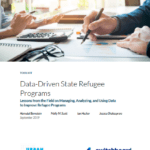This blog post was written by Jessica Shakesprere and Ian Hecker of the Urban Institute. It accompanies a new toolkit developed by the Urban Institute as part of the Switchboard program: Data-Driven State Refugee Programs: Lessons from the field on managing, analyzing, and using data to improve refugee programs.
Many states that welcome refugees lack data and evidence on how refugees are faring and how programming can help them adjust to life in the United States. Without this evidence, states are less able to counter misperceptions about their programs or understand how to best allocate scarce funding for optimal outcomes.
State refugee coordinators (SRCs) manage and coordinate a wide range of state refugee services. They’re also responsible for collecting and reporting data to the federal Office of Refugee Resettlement (ORR). But gathering and reporting data isn’t easy. SRCs face a range of challenges related to data collection, analysis, and use, and the people they serve are diverse in terms of language, culture, and location.
As part of the Switchboard program, to the Urban Institute released a data toolkit aimed at addressing these challenges. Based on direct input from SRCs, the toolkit explores how SRCs are using existing data and gathering new data to guide program management. The toolkit can help SRCs and other service providers learn strategies for effectively organizing and sharing data.
Here are three ways SRCs are using data to bolster their services for refugees:
1. Working with research partners and engaging refugees
The Colorado SRC worked with an outside research partner to conduct a four-year longitudinal study of refugee integration in metropolitan Denver between 2011 and 2015.
Colorado paired community members with researchers to make information richer and data collection more effective. The research found that the speed at which refugees integrate into their communities varies by age, which is information the SRC could use to ramp up service offerings to those facing barriers.
2. Leveraging existing data
Data on refugees’ outcomes can also be used to set performance standards for SRCs’ grantees. In Illinois, the SRC uses a federal form to track outcomes for employment services to make decisions on what outputs they should hold grantees to, including average wages for refugees who receive employment services and secure a job, availability of employer-provided health insurance, and job retention.
In Connecticut, the SRC is using ORR reporting forms to ensure that individuals are served in the correct federal fiscal year, to forecast future contract sizes for financial planning, and to observe trends in grantees’ caseloads.
3. Thinking about important outcomes
Federal reporting for refugee programs often asks for narrowly defined data on employment and economic self-sufficiency. But these data don’t always accurately reflect the integration process and don’t capture refugees’ experiences or the full outcomes of the services and supports that grantees offer. In response, some SRCs have started developing their own ways of defining and measuring outcomes for the refugees they serve.
In Utah, the SRC worked together with grantees to more holistically define integration and design an assessment tool that would track a broader set of outcomes, like learning English and independent life skills, which were meaningful to both providers and participants in ORR-funded programs.
These outcomes were chosen because they communicate to the state how refugees are faring in society, instead of narrowly reflecting what’s required in the reporting forms (dates of service, information about employment, and so on), which can overlook critical indicators of progress.
The SRC data toolkit includes these and many more lessons that can help states learn from each other and the field to more effectively use data to improve refugee services.










